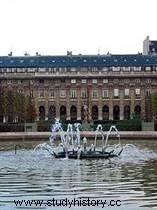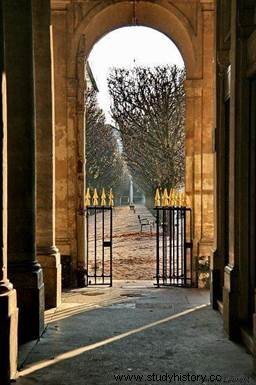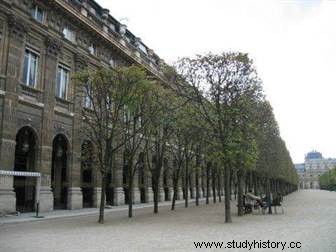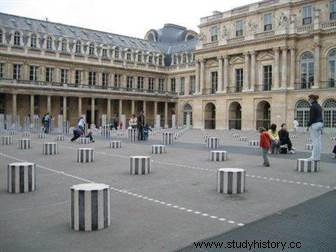 Long closed to the public, the Palais-Royal built by Richelieu has now regained its former function as a place for walking and entertainment. The Garden of the Royal Palace is at the center of a quadrilateral closed on all four sides:one side houses the Council of State, the Constitutional Council, the Comédie Française and the other three are galleries hosting the Ministry of Culture, fashion boutiques, furniture and antiques and cafes. President François Mitterrand made embellishments, adorning the courtyard with columns by Buren (1985-1986) and mobile spheres by Pol Bury (1985).
Long closed to the public, the Palais-Royal built by Richelieu has now regained its former function as a place for walking and entertainment. The Garden of the Royal Palace is at the center of a quadrilateral closed on all four sides:one side houses the Council of State, the Constitutional Council, the Comédie Française and the other three are galleries hosting the Ministry of Culture, fashion boutiques, furniture and antiques and cafes. President François Mitterrand made embellishments, adorning the courtyard with columns by Buren (1985-1986) and mobile spheres by Pol Bury (1985).
The Palais-Cardinal de Richelieu
In Gallo-Roman times, the location of the Royal Palace and the garden was located northwest of Lutèce in the Rouvray forest. During the planting of trees in 1781, two rather impressive surface basins were discovered, which suggests that there may have been the first Parisian spa at this location. According to the medals found, it dates from the 270s. In some places, the depth was two meters below the level. Researchers believe its use ceased after about a hundred years.
 Richelieu, who became a minister in 1624, wanted to get closer to the Louvre. He built a first residence near the Charles V enclosure, then to enlarge it bought the surrounding land during the demolition of this enclosure in 1633:the building took the name of Palais Cardinal. The garden housed two large ponds with fountains, statues, flowerbeds and was surrounded by two paths of elms and a small wood. Before his death, Richelieu bequeathed his palace to King Louis XIII. Anne of Austria, who became Regent, left the Louvre with her two children to live in this palace, which became the Royal Palace in October 1643.
Richelieu, who became a minister in 1624, wanted to get closer to the Louvre. He built a first residence near the Charles V enclosure, then to enlarge it bought the surrounding land during the demolition of this enclosure in 1633:the building took the name of Palais Cardinal. The garden housed two large ponds with fountains, statues, flowerbeds and was surrounded by two paths of elms and a small wood. Before his death, Richelieu bequeathed his palace to King Louis XIII. Anne of Austria, who became Regent, left the Louvre with her two children to live in this palace, which became the Royal Palace in October 1643.
Mazarin, in 1644, stayed in the Hotel Tubeuf, the current National Library and crossed the garden to go to the Queen.
It was during this period that little Louis XIV almost drowned in the large pond in the garden. He had as a playmate, the daughter of a servant of the Queen's maids, it was with her also that he played King and Queen in the kitchens of the palace. In this garden, Mazarin organized miniature hunts for the king, taught him to ride a horse and Louis was introduced to war on a small fort. But the Fronde put an end to this happy time.
The transformations of the Royal Palace
The first transformations took place in 1730:the old elms were felled, the two basins merged into one, with a water jet. Under Louis XV, the garden opened to the public saw the installation in the main aisle of a bookseller's hut, the appearance of young ladies of little virtue, the planting of the Tree of Krakow around which gathered novelists, strollers, idlers, as well as the installation of benches. Not far from there, Diderot strolled there regularly towards the end of the afternoon “whether the weather is nice or the weather ugly, it’s my habit to go around five o’clock in the evening to walk around the Palais Royal; it’s me that you always see alone, dreaming on the Argenson bench”.
 Philippe d'Orléans will restore the palace and give it its current structure. He had around sixty pavilions built from 1781 to 1784 on the three sides of the garden. These arcaded pavilions, designed by the architect Victor Louis, are occupied on the ground floor by shops and galleries and upstairs by private individuals. This architect also restored the buildings of the palace, in particular the opera house, which burned down, which became the Théâtre-Français. During the Revolution, the palace, an active center of popular unrest, was acquired by the State in 1793. Subsequently confiscated by the Bonaparte family, the palace became a monument of the State under the Restoration. Louis-Philippe restored it by replacing the wooden galleries with vast porticoes in the classical style.
Philippe d'Orléans will restore the palace and give it its current structure. He had around sixty pavilions built from 1781 to 1784 on the three sides of the garden. These arcaded pavilions, designed by the architect Victor Louis, are occupied on the ground floor by shops and galleries and upstairs by private individuals. This architect also restored the buildings of the palace, in particular the opera house, which burned down, which became the Théâtre-Français. During the Revolution, the palace, an active center of popular unrest, was acquired by the State in 1793. Subsequently confiscated by the Bonaparte family, the palace became a monument of the State under the Restoration. Louis-Philippe restored it by replacing the wooden galleries with vast porticoes in the classical style.
The garden of the Royal Palace
In the 18th century, the garden was reduced by about a third due to the construction of the surrounding streets. Despite this, it would experience unparalleled activity and life, more intense than Place Royale:it was open until 11 p.m. in winter and 1 a.m. in summer. Soldiers, women in aprons and people in livery were forbidden there, only couples and beautiful ladies exhibited themselves there, it was there that Bonaparte made his first conquest in 1787.
The police being forbidden in this garden, the beginnings of the Revolution were born there, when Camille Desmoulins climbed on a table to call on the people to raise their arms, the leaves torn from the trees serving as cockades and rallying signs. The galleries around the garden were the place of various meetings:both intellectuals and prostitutes, gambling dens, gambling circles, literary cabinets, restaurants that were to become famous.
Under Charles X (1824-1830), the garden was further modified and in 1836 it took on its current appearance when the gambling houses disappeared. During the Belle Epoque, the garden finally welcomed all kinds of people:well-dressed families as well as proletarians.
Nowadays
Its alleys are lined with lime trees and red chestnut trees, there is a central basin decorated with water jets, flowered plots, a real haven of peace in the heart of Paris. In the center of the garden, marble statues such as the Snake Charmer and the Shepherd and the Goat invite you to daydream.
 In 1986, Daniel Buren installed his black and white marble columns at the entrance to the garden, in the main courtyard of the Royal Palace. The introduction of a contemporary work of art in a high place of French heritage in the heart of Paris will arouse many controversies. The garden has also been used since 1997 as a place for temporary exhibitions of sculptures.
In 1986, Daniel Buren installed his black and white marble columns at the entrance to the garden, in the main courtyard of the Royal Palace. The introduction of a contemporary work of art in a high place of French heritage in the heart of Paris will arouse many controversies. The garden has also been used since 1997 as a place for temporary exhibitions of sculptures.
To go further
- Knowledge of Old Paris – Jacques Hillairet. Shores, April 2005.
- The Royal Palace (Lambert/Massounie). Routes, 2010.
- History of the Palais-Royal:The two trays, by Daniel Buren. Actes Sud, 2010.
